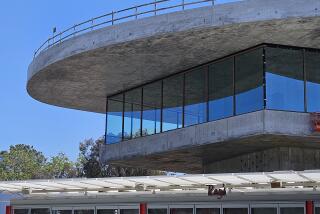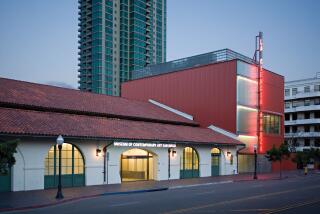How Fullerton Lost Out on Art Museum : Background: The city where his industrial empire began as a juice stand was to be home of his collection. But a spat with City Council sent it to Pasadena instead.
FULLERTON â If not for a fight Norton Simon had with the Fullerton City Council over a parking lot and the cost of guarding the art, his renowned Pasadena museum may have been built here, where he parlayed an orange juice stand into Hunt Foods.
Simon, who died Thursday, was prepared in 1964 to build such a museum for Fullerton, according to art historians and old newspaper stories. He already had donated the Hunt Library and an adjoining park to the city and was willing to spend up to $500,000 to build a museum to house the artworks he had been collecting. The city was set to donate the land.
But it never got built.
âItâs a sad thing,â said Lawrence Macaray, a retired art professor who lives in Anaheim. âHe was offering it to the city on a silver platter. When you think about the three top museums in California, you think of the J. Paul Getty Museum in Malibu, the Los Angeles County Museum of Art and the Simon Museum. We could have had that right here.
âThere is no question that such a museum would have hastened the arrival of the county and Fullerton as art colonies. But the city reneged on its part of the deal.â
Itâs not that simple, said longtime Councilman A.B. (Buck) Catlin. He was not yet on the council then--many who were are now dead--but he remembers talking to them about the proposal and the reasons for its eventual defeat.
âThere was concern about how to control the traffic and who would pay for the security,â Catlin said. âHe wanted the city to hire quite a bit of security, and the city couldnât afford it. We were a small city.â
For two years, the city and Simon negotiated. Then in October, 1966, Simon announced that he had withdrawn his offer and that the $500,000 would be used for other purposes. When San Clemente made a bid for the museum in 1968, Fullerton tried to resurrect its own plan. But Simon decided to go outside Orange County and opened his Pasadena museum in 1974.
Leon Lyon, a trustee of the Newport Harbor Art Museum who led a committee of local art supporters seeking to make the Simon museum in Fullerton a reality, recounted a wholly different version of the affair.
Simon wanted the Fullerton community to pay $250,000 for a small piece of land for the museum next to his Hunt headquarters âas a test to find out if there was grass-roots interest in the idea,â Lyon said. But the community âdidnât respond,â he said, and the plan died.
âThe community seemed to be saying, âHeâs got a lot of money, what does he need $250,000 (from us) for?â â Lyon said.
Fullerton resident and longtime Orange County arts patron Elaine Redfield, who knew Simon well and served on Lyonâs committee, said Simon was âreally disappointedâ when the plan fell through.
âAnd we were too,â said Redfield, a former trustee of the Orange County Performing Arts Center. âIt would have given renown to the city.â
Simon ran his empire from Hunt Foods Inc. in Fullerton until his retirement in 1968, when the company moved to New York City.
But its Hunt-Wesson processing plant remains on Commonwealth Avenue, employing about 2,000 people.
Kay Carpenter, spokeswoman for the plant, said that even though Simon was not technically the companyâs founder, that is how he is regarded in its history.
âHe was its driving force,â Carpenter said. âHe basically took a business that was defunct here in Fullerton, utilized the Hunt brothersâ name, and created the tomato products that made it such a success.â
Times staff writer Zan Dubin contributed to this story.
More to Read
Sign up for Essential California
The most important California stories and recommendations in your inbox every morning.
You may occasionally receive promotional content from the Los Angeles Times.









